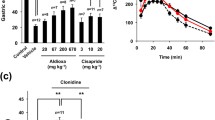Abstract
Acute haemorrhagic lesions in the oesophagus, stomach and duodenum (‘stress ulcers’) occur relatively often under clinical conditions and are always dangerous to the patient (lethality rate about 70%). Since conservative and surgical treatment are without significant success up to now, prevention by adaptation to stressors or by administration of drugs seems mandatory.
An improved technique for producing acute gastric lesions in rats by immobilization and a new method for assessing this disease in the animals is presented in this communication. High precision is obtained within a single experimental series especially from day to day.
Since histamine was suggested to be involved in the pathogenesis of stress ulcer disease, (+)-catechin, a rather specific inhibitor of specific histidine decarboxylase from rat stomach, was tested in immobilized rats. It prevented the formation of acute gastric lesions by 80% in seven series of experiments lasting for half a year. Since the drug has low toxicity in man, it is recommended for clinical trials.
Similar content being viewed by others
References
W. Lorenz andG. Feifel,Neue Gesichtspunkte zur Pathogenese des Streß- und Steroidulkus, Dtsch. Med. Wschr.95, 1848 (1970).
W. Seidel, W. Lorenz, A. Doenicke, G. Mann, R. Uhlig andH. Rohde,Histaminfreisetzung beim Menschen und Stressulcuspathogenese, Z. Gastroenterol.11, 297 (1973).
R.J. Levine,Histamine Synthesis in Man: Inhibition by 4-Bromo-3-Hydroxybenzyloxyamine, Science154, 1017 (1966).
K.-Fr. Sewing andB. Binder,The Effect of Brocresine (NSD-1055) on Diamine Oxidase Levels in the Rat Plasma, Liver, Stomach and Upper Small Intestine in vivo and vitro, in:Histamine (Ed. Cz. Maslinski; Dowden, Hutchinson & Ross, Stroudsburg, Pennsylvania, 1973), p. 306.
W. Lorenz, J. Kusche, H. Barth andCh. Mathias,Action of Several Flavonoids on Enzymes of Histamine Metabolism in vitro, in:Histamine (Ed. Cz. Maslinski; Dowden, Hutchinson & Ross, Stroudsburg, Pennsylvania, 1973), p. 265.
W. Lorenz, H.-J. Reimann, J. Kusche, H. Barth, A. Schmal, H. Nusimé, G. Schülle, R. Froelich, J. Schmidt andR. Raabe,Effects of (+)-Catechin on Several Enzymes of Histamine Metabolism and on Stress Ulcer Formation in the Female Rat, Naunyn-Schmiedeberg's Arch. Pharmacol. Suppl.287, 62 (1975).
G.W. Snedecor andW.G. Cochran,Statistical Methods (Iowa State University Press, 1967), p. 62.
H.U. Bergmeyer,Methods of Enzymatic Analysis, sec. Engl. Ed., Chemie Weinheim (Academic Press, Inc., New York and London, 1974).
H.M. Hanson andD.A. Brodie,Use of the Restrained Rat Technique for Study of the Antiulcer Effect of Drugs, J. Appl. Physiol.15, 291 (1960).
S. Yano andM. Haraoa,A Method for the Production of Stress Erosion in the Mouse Stomach and Related Pharmacological Studies, Japan. J. Pharmacol.23, 57 (1973).
W. Lippmann,Inhibition of Gastric Acid Secretion and Ulcer Formation in the Rat by Orally Administered II-Deoxyprostaglandin Analogues: 15-hydroxy-16, 16-Dimethyl-9-deoxoprostaglandin-5, 13-dienoic acid, Prostaglandins7, 231 (1974).
S. Sethbhakdi, C.J. Pfeiffer andJ.L.A. Roth,Gastric Mucosal Ulceration Following Vasoactive Agents. A New Experimental Model, Digestive Diseases15, 261 (1970).
A. Robert, J.I. Northam, I.E. Nezamir andI.D. Phillips,Exertion Ulcers in the Rat, Digestive Diseases15, 497 (1970).
W. Lorenz, St. Halbach, M. Gerant andE. Werle,Specific Histidine Decarboxylases in the Gastric Mucosa of Man and Other Mammals: Determination, Location and Properties, Biochem. Pharm.18, 2625 (1969).
W. Lorenz, H. Barth, J. Kusche, H. Troidl, H. Rohde, A. Schmal, W. Stenner, H. Nusime, G. Häfner, R. Glass andA. Friedrich,Critical Review Concerning Metabolism and Physiological Function of Histamine in the Gastric Mucosa, Satellite Symposium on Gastrointestinal Hormones, Krakow 1974 (in press).
M.N. Gleason, R.E. Gosselin andH.C. Hodge,Clinical Toxicology of Commercial Products (Williams and Wilkins Company, Baltimore, 1963).
Author information
Authors and Affiliations
Additional information
Supported by a grant from Deutsche Forschungsgemeinschaft (SFB 122/D5 ‘Adaptation und Rehabilitation’).
Rights and permissions
About this article
Cite this article
Reimann, H.J., Lorenz, W., Fischer, M. et al. Histamine and acute haemorrhagic lesions in rat gastric mucosa: Prevention of stress ulcer formation by (+)-catechin, an inhibitor of specific histidine decarboxylase in vitro. Agents and Actions 7, 69–73 (1977). https://doi.org/10.1007/BF01964883
Received:
Issue Date:
DOI: https://doi.org/10.1007/BF01964883




